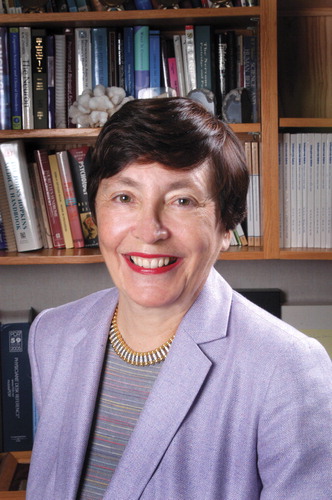Farewell, Thou Child of My Right Hand
Nearly 13 years ago, in March of 1993, I assumed the role of Editor-in-Chief of TheAmerican Journal of Psychiatry and continued in this position through December of 2005. Now, in January of 2006, I am stepping down from that role. At the time that I became Editor-in-Chief, the APA Board of Trustees created a term limit of 13 years for editors, based on the reasoning that “it is good to pass these responsibilities around.” Although I requested that the term limit be waived, since it had not been enforced for other editors, the Board decided to stand by the term limit in my case. The Board made it clear, however, that they were pleased with my editorship. They were just “following the rules.”
I explain this because I want to make it clear how much I have enjoyed editing this journal and how much I would have liked to continue. The American Journal of Psychiatry has been my beloved child for the past 13 years, and it was difficult for me to contemplate giving it up for adoption to a new parent. Being a psychiatrist, I could easily diagnose myself as suffering from a grief reaction. The grief has subsided, however, with the knowledge that the Journal will be in good hands with its new Editor-in-Chief, Robert Freedman, and that continuity will be ensured because my much-valued Deputy Editors will remain in place, as will our wonderful editorial staff, led ably by Managing Editor Sandra Patterson. My child will continue to grow and mature as it moves on to a new phase in its life.
Bob Freedman is a superb choice as the next Editor-in-Chief of your journal. (I say “your journal” because I have always felt that the Journal really belongs to its readers and authors, who come from all over the world. The editor is merely a steward who has “protective custody” for a designated period of time.) Bob brings extensive editorial experience from having been a key psychiatric representative on the Editorial Board of TheNew England Journal of Medicine. He is a much-admired scholar and scientist. He is the Principal Investigator of a Silvio Conte Center study examining the translational neuroscience of mental disorders and is also the Principal Investigator on multiple other investigator-initiated research grants. He has demonstrated his leadership abilities in many ways, such as serving as Chair of Psychiatry at the University of Colorado and on the NIMH Scientific Advisory Council. But in addition to these obvious credentials, he has others as well. As a medical student and intern at Harvard, he was privileged to attend courses taught by my beloved predecessor as Editor-in-Chief: John Case Nemiah. Consequently, Bob brings to the Journal a breadth of perspective that embraces all aspects of clinical psychiatry. He also has a humanistic bent. He confesses to playing the piano badly but frequently, with a preference for Mozart. In short, he has many qualities that will permit him to serve our field and our Journal well.
After 13 years, I must inevitably look back on how psychiatry and the Journal have changed over that time. When I became Editor-in-Chief, I adopted a journal that had a stately dark green cover on which special articles were listed and which used a handsome serif type font inside. While I admired the look, I decided to update it, putting some of my own artistic tastes and talents to use. The “green journal” remained green in its L-shaped title frame, but it acquired a changing multicolored picture on the cover each month, designed to highlight that issue’s particular theme. I wanted more than brain scans or images of pathology on the cover. Because our field is about people, I wanted to have human beings on the cover as much as possible. Thanks to the artistic talents of Jason Glance, we were able to achieve this goal with steadily increasing sophistication. I like to imagine that our readers look forward to receiving their issues each month—wondering what the theme will be or what the cover will portray. We added lots of color to the inside contents of the Journal as well—giving each of the sections its own color trademark, thereby making it easier for readers to leaf through and find their favorite sections.
Working with a varied and wonderful group of people who have served on the Journal Editorial Board over the years, we have been able to steadily enrich its contents. Our goal was to have something for everyone—high-quality science combined with clinical appeal. Editorials were invited for each issue, usually chosen to discuss the significance of the issue theme and a few of the specific articles written about that theme. Creating a visually interesting and beautiful journal was important to me. Consequently, “Images in Psychiatry” was an early addition, devoted to celebrating the rich history of psychiatry by highlighting an important leader, place, or event. “Images in Neuroscience” made a parallel visual contribution by providing images combined with “mini-tutorials” that readers could use to obtain a quick update on complex subjects—neuroanatomy, neuroimaging, neuropharmacology, or cognitive neuroscience, for example. We created “Clinical Case Conferences” so that a variety of different clinical challenges could be described. We added “In This Issue,” a succinct summary of some of the most important articles published in a given month. “Introspections” were introduced so that non-scientist writers could contribute insights about psychiatry based on personal experiences. We expanded our audience and our scientific quality by accepting manuscripts submitted from all over the world. In a sense, The American Journal of Psychiatry has become the international journal of psychiatry, reflecting the fact that the United States does not have a monopoly on high-quality scientific research.
During my tenure, the Journal also moved into the electronic age. One reason that the Journal is of such high quality and is so visually attractive is that we have a resident staff that lovingly produces each issue through the wonders of desktop publishing. We also made the Journal available online at a relatively early date (August 1997). And most recently, we introduced online reviews.
During my tenure, I also learned about how to make hard choices. As the Journal steadily improved, the number of submissions increased. Accepting manuscripts is more pleasant than rejecting them, and yet I have had to turn down many worthy submissions. I appreciate the understanding and grace with which most of our authors have accepted these decisions.
As the Journal changed, so did our field. A variety of forces and factors have created difficult challenges that all psychiatrists must face. The basic science upon which psychiatry is based—neuroscience—is moving forward with lightning speed, making it difficult for all of us to keep up with it. Changes in the health care delivery system have made it more and more difficult for psychiatrists to give their patients the time and attention that they need and deserve. Efforts to standardize techniques for diagnosing and treating may have improved consistency, but with some loss of a much-needed emphasis on intuitive empathy and on art in addition to science.
Nonetheless, in January of 2006 we as psychiatrists have much to be proud of about the nature of our field and the contributions that we make to society. We remain the most humanistic discipline within medicine. We serve some of the most disadvantaged or most misunderstood individuals in society, and most of us do it altruistically and effectively. We are privileged to be trusted by our patients, who share their most private lives with us. Much of the time we are able to offer them a helping hand—the greatest pleasure that a human being can experience.
So, in closing, I’d like to say that it has been an honor to be your Editor-in-Chief for 13 years. I have done my best to serve all of you well and fairly—my own small way of expressing appreciation for the service you provide to humanity by working as psychiatrists.

Nancy C. Andreasen, M.D., Ph.D.



